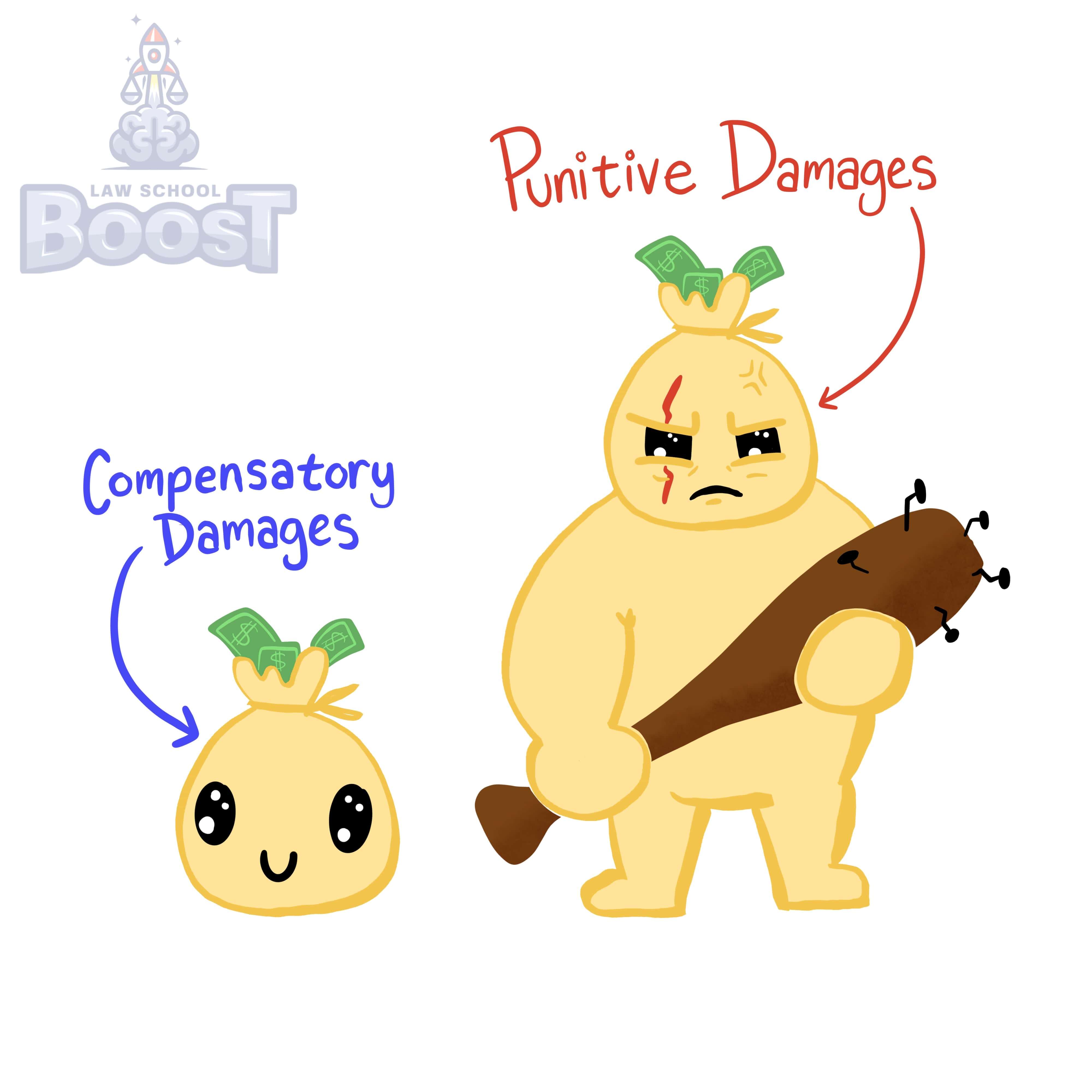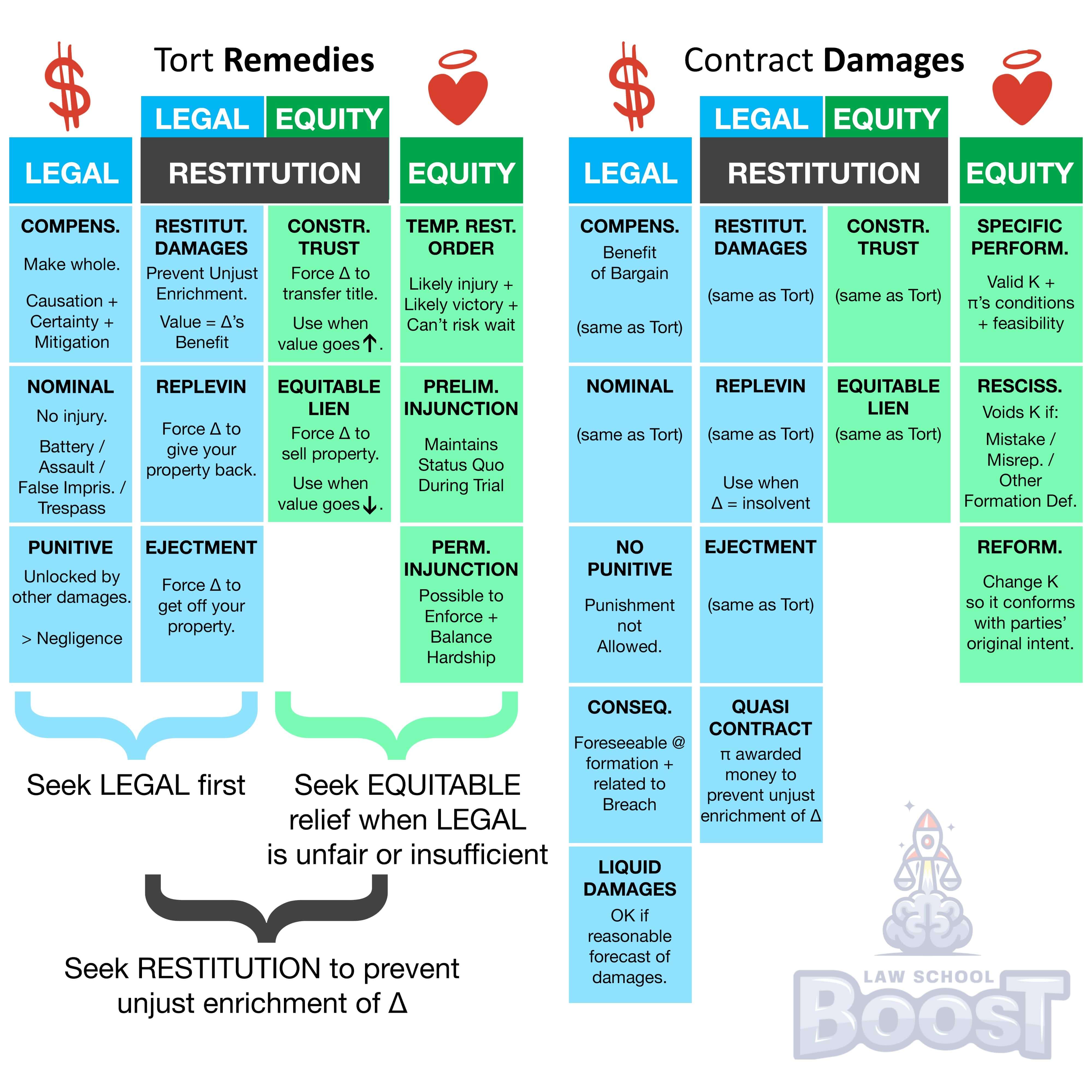🏥
Remedies • Tort - Legal Remedies
REM#011
Legal Definition
Punitive damages are awarded in order to punish the defendant, but in order to get punitive damages, a plaintiff must first have been awarded compensatory, nominal, or restitutionary damages. In order for punitive damages to be available, the defendant's fault must be greater than negligence.
Generally, punitive damages are awarded in an amount relatively proportionate to actual damages, and the Supreme Court of the United States ("SCOTUS") has limited them to a single digit multiplier of actual damages unless the conduct or facts are extreme.
Generally, punitive damages are awarded in an amount relatively proportionate to actual damages, and the Supreme Court of the United States ("SCOTUS") has limited them to a single digit multiplier of actual damages unless the conduct or facts are extreme.
Plain English Explanation
When someone causes harm to someone else, courts generally step in to make sure they pay for it or face some sort of fair consequence for their action. But sometimes people cause harm to others in ways that are so messed up, so stupid, so negligent, or even so evil that courts want to make an example out of them. They want to punish the person so harshly that it lets the community know "not only is this not tolerated, this person is a bad human being and we're going to legally spank them by making them pay even more money."
Punitive damages are a multiplier of other damages, like compensatory, nominal, or restitutionary (which you'll learn about in other cards). This means once a court or jury has established a certain amount of damages, punitive damages take that amount and multiply it by some number. What number? It depends on how messed the defendant's actions are. Generally speaking, the supreme court has limited the multiplier to single digit numbers, meaning if the actual damages are calculated to be $1,000, then a jury may be able to multiply it by 2, 3, 4, 5, 6, 7, 8, or 9. However, if actual damages are calculated to be $1,000 but a jury tried to award $10,000 in punitive damages (a 10x multiple), this would be in violation of the SCOTUS limitations unless the actions are extremely fucked up.
Punitive damages are a multiplier of other damages, like compensatory, nominal, or restitutionary (which you'll learn about in other cards). This means once a court or jury has established a certain amount of damages, punitive damages take that amount and multiply it by some number. What number? It depends on how messed the defendant's actions are. Generally speaking, the supreme court has limited the multiplier to single digit numbers, meaning if the actual damages are calculated to be $1,000, then a jury may be able to multiply it by 2, 3, 4, 5, 6, 7, 8, or 9. However, if actual damages are calculated to be $1,000 but a jury tried to award $10,000 in punitive damages (a 10x multiple), this would be in violation of the SCOTUS limitations unless the actions are extremely fucked up.
Hypothetical
Hypo 1: Sam, an amateur magician with dreams of having his own magic show in Vegas, invents a deck of cards that change suits and numbers when he clicks a button in his jacket. With a single click, an Ace of Clubs can become a 2 of Hearts, or anything he desires. Pretty genius. He starts practicing with the deck and makes the mistake of showing Bob, who is blown away by how clever it is. While Sam is away, Bob steals the deck of cards and leaves a note that says "You'll never make it as a magician. Also, I never really liked you and all my friends think you're a loser." Bob starts his own show with the cards and makes $10,000 before Sam decides to sue him. Result: The jury will likely award Sam restitutionary damages and, because Bob left such a nasty note for Sam, they may also award punitive damages and multiply that amount. Because the multiplier has to be a single digit, the maximum Bob could pay is $90,000 in punitive damages on top of the $10,000 of restitutionary damages.
Hypo 2: Amy's got a bone to pick with the city she lives in. One day, she is inspired by an episode of Phineas & Ferb where Dr. Doofenshmirtz attempts to take over the tri-state area. Amy decides to take over the city herself––and stop anyone who'll get in her way. To do this, she builds an evil ray that will disintegrate anything it hits. Not really sure it'll work, she aims the ray at Jill's foot and Jill's foot disappears. Even though she has to hop around on one foot, Jill manages to tie up Amy and turn her in to the police. Result: Jill can sue Amy for compensatory damages for her injury and the expenses she'll rack up in the future because of it. In this case, Amy is also exceptionally evil, so Jill can get punitive damages as well to really punish Amy for her evil deed — possibly beyond the single-digit multiplier limitation.
Hypo 3: Sam trips on a small pothole in a grocery store parking lot and sprains his ankle. Although the store had neglected maintenance, the condition was not hidden or particularly dangerous. Result: Negligence causing actual injury allows compensatory damages to Sam, but the behavior was likely not reckless enough for punitive damages.
Hypo 2: Amy's got a bone to pick with the city she lives in. One day, she is inspired by an episode of Phineas & Ferb where Dr. Doofenshmirtz attempts to take over the tri-state area. Amy decides to take over the city herself––and stop anyone who'll get in her way. To do this, she builds an evil ray that will disintegrate anything it hits. Not really sure it'll work, she aims the ray at Jill's foot and Jill's foot disappears. Even though she has to hop around on one foot, Jill manages to tie up Amy and turn her in to the police. Result: Jill can sue Amy for compensatory damages for her injury and the expenses she'll rack up in the future because of it. In this case, Amy is also exceptionally evil, so Jill can get punitive damages as well to really punish Amy for her evil deed — possibly beyond the single-digit multiplier limitation.
Hypo 3: Sam trips on a small pothole in a grocery store parking lot and sprains his ankle. Although the store had neglected maintenance, the condition was not hidden or particularly dangerous. Result: Negligence causing actual injury allows compensatory damages to Sam, but the behavior was likely not reckless enough for punitive damages.
Visual Aids


Related Concepts
In assessing compensatory damages for legal remedies in tort, how important is certainty and how is it assessed?
In assessing compensatory damages for legal remedies in tort, how must the judgment be paid?
In assessing compensatory damages for legal remedies in tort, what are general damages?
In assessing compensatory damages for legal remedies in tort, what are special damages?
In assessing compensatory damages for legal remedies in tort, what is foreseeability?
In assessing compensatory damages for legal remedies in tort, what is unavoidability?
In assessing compensatory damages, what is causation?
In assessing legal remedies in tort, what are compensatory damages?
What are legal remedies in tort?
What are nominal damages for legal remedies in tort and what suits are they applicable to?


